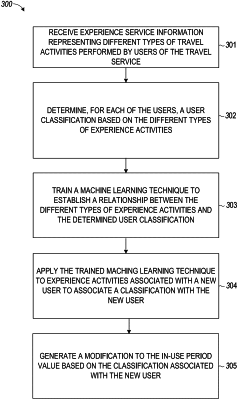| CPC G06Q 10/025 (2013.01) | 20 Claims |

|
1. A method comprising:
setting, by an experience-based subscription service, a number of subscription value days;
determining an amortized subscription parameter for a subscriber of the experience-based subscription service, the amortized subscription parameter representing a subscription cost accumulated over the number of subscription value days;
identifying, by the experience-based subscription service, a plurality of experience-related resources available for access on future experience dates, each of the plurality of experience-related resources having a cost that satisfies the amortized subscription parameter;
receiving, on a booking date, a request from the subscriber to reserve a given experience-related resource of the plurality of experience-related resources; and
in response to receiving the request, preventing the subscriber from reserving a second experience-related resource during an in-use period that is initially computed to begin on the booking date and terminate after a period of time corresponding to the number of subscription value days, wherein the in-use period is modified based on:
applying a machine-learning model to associate the subscriber with a classification, wherein the machine-learning model is trained to establish a relationship between user travel activity and user classification, and wherein the machine-learning model is trained in a learning phase comprising a preset number of epochs based on a fixed computing budget; wherein the learning phase is configured to terminate upon the first of:
either a model accuracy threshold being satisfied, or the number of epochs being reached;
and adjusting the in-use period based on the classification of the subscriber.
|